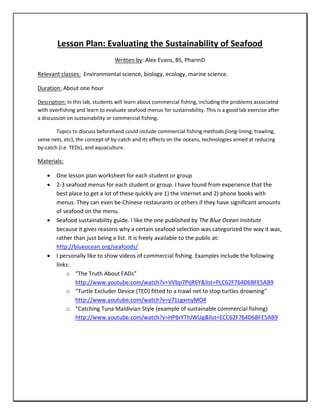Report
Share
Download to read offline

Recommended
Recommended
A career in marine biology offers a variety of options for research and conservation, from investigating coral reefs to solving the mysteries of deep-sea animals.Career in Marine Biology: Educational Options, Employment Opportunities & Mor...

Career in Marine Biology: Educational Options, Employment Opportunities & Mor...The Lifesciences Magazine
This presentation is Part 3 of a training program on Food Safety Practices for the Aquaculture Industry by Michigan State University, on 22 April 2013.Aquaculture 3 - Food Safety Practices for Aquaculture Production 2013

Aquaculture 3 - Food Safety Practices for Aquaculture Production 2013Asian Food Regulation Information Service
More Related Content
Viewers also liked
Viewers also liked (7)
2e Conférence Lean Construction France 10 mai 2016

2e Conférence Lean Construction France 10 mai 2016
Similar to Seafood Sustainability AEvans
A career in marine biology offers a variety of options for research and conservation, from investigating coral reefs to solving the mysteries of deep-sea animals.Career in Marine Biology: Educational Options, Employment Opportunities & Mor...

Career in Marine Biology: Educational Options, Employment Opportunities & Mor...The Lifesciences Magazine
This presentation is Part 3 of a training program on Food Safety Practices for the Aquaculture Industry by Michigan State University, on 22 April 2013.Aquaculture 3 - Food Safety Practices for Aquaculture Production 2013

Aquaculture 3 - Food Safety Practices for Aquaculture Production 2013Asian Food Regulation Information Service
Marine Stewarship Council promote the sustainable seafood option.II Taller Alianza Eco-region Caribe Sur / MIZC.Promoting sustainable seafood

II Taller Alianza Eco-region Caribe Sur / MIZC.Promoting sustainable seafoodTaller_Alianza_Caribe_Sur
Similar to Seafood Sustainability AEvans (20)
Career in Marine Biology: Educational Options, Employment Opportunities & Mor...

Career in Marine Biology: Educational Options, Employment Opportunities & Mor...
Aquaculture 3 - Food Safety Practices for Aquaculture Production 2013

Aquaculture 3 - Food Safety Practices for Aquaculture Production 2013
Research Progress Report Table Adjust answer box size as necessar.docx

Research Progress Report Table Adjust answer box size as necessar.docx
Popular Unsustainable and Environmentally Concerning Aqu.docx

Popular Unsustainable and Environmentally Concerning Aqu.docx
The Monterey Bay Aquarium's Seafood Watch Program: Promoting Ethical Consumption

The Monterey Bay Aquarium's Seafood Watch Program: Promoting Ethical Consumption
Best practices for catch-and-release recreational fisheries

Best practices for catch-and-release recreational fisheries
The Awik-awik: Revitalization of Rights-based Fisheries in Jor Bay, East Lomb...

The Awik-awik: Revitalization of Rights-based Fisheries in Jor Bay, East Lomb...
II Taller Alianza Eco-region Caribe Sur / MIZC.Promoting sustainable seafood

II Taller Alianza Eco-region Caribe Sur / MIZC.Promoting sustainable seafood
Seafood Sustainability AEvans
- 1. Lesson Plan: Evaluating the Sustainability of Seafood Written by: Alex Evans, BS, PharmD Relevant classes: Environmental science, biology, ecology, marine science. Duration: About one hour Description: In this lab, students will learn about commercial fishing, including the problems associated with overfishing and learn to evaluate seafood menus for sustainability. This is a good lab exercise after a discussion on sustainability or commercial fishing. Topics to discuss beforehand could include commercial fishing methods (long-lining, trawling, seine nets, etc), the concept of by-catch and its effects on the oceans, technologies aimed at reducing by-catch (i.e. TEDs), and aquaculture. Materials: One lesson plan worksheet for each student or group 2-3 seafood menus for each student or group. I have found from experience that the best place to get a lot of these quickly are 1) the internet and 2) phone books with menus. They can even be Chinese restaurants or others if they have significant amounts of seafood on the menu. Seafood sustainability guide. I like the one published by The Blue Ocean Institute because it gives reasons why a certain seafood selection was categorized the way it was, rather than just being a list. It is freely available to the public at: http://blueocean.org/seafoods/ I personally like to show videos of commercial fishing. Examples include the following links: o “The Truth About FADs” http://www.youtube.com/watch?v=VVbp7PijR6Y&list=PLC62F764D6BFE5AB9 o “Turtle Excluder Device (TED) fitted to a trawl net to stop turtles drowning” http://www.youtube.com/watch?v=y71cgxmyMO4 o “Catching Tuna Maldivian Style (example of sustainable commercial fishing) http://www.youtube.com/watch?v=HP6rYThJWUg&list=ECC62F764D6BFE5AB9
- 2. Key Vocabulary: Sustainability Commercial fishing By-catch Fish Aggregating Device (FAD) Turtle Excluder Device (TED) Aquaculture Objectives: Understand the key vocabulary listed above Learn to critically evaluate seafood menus to determine the menu choices’ effects on the oceans Understand some underlying reasons behind why fish stocks decline over time Gain insight into the ways in which consumers can drive social change
- 3. Page 1 Group members:_______________________________________________________________ Evaluating the Sustainability of Seafood Today we are going to evaluate the sustainability of the seafood that is served in local restaurants. To do that, we are going to use the Blue Ocean Institute’s Guide to sustainable seafood, which provides not only a rating of best and worst choices but also an explanation of why it was put in that category. Each group will be given several menus to answer these questions. Name three different items on the menus that are the best or good choices and why: 1- 2- 3- Name three different items on the menus that are either bad or the worst choices and why: 1- 2- 3-
- 4. Page 2 Name an item that was on the menu but was not descriptive enough to be able to determine whether or not it was a good choice. What additional information was needed? Why does that information matter in terms of sustainability? Pick one of the restaurants and evaluate the seafood on their menu. Assign them a grade of A through F and give an explanation of your grade.